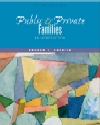EXERCISE 1 The first way to obtain information on the family is pure web surfing: Click the search button on your Internet browser and enter a phrase; the search engine will respond with corresponding links to web sites. As you know, the phrase can't be too broad: Entering "family" will cause the search engine to return a blizzard of links. But a more focused entry can be useful: Typing "civil union" or "domestic partnership" for example, should return a number of useful links about same-sex partnerships and marriage. It may also, however, return some not-so-useful links; and it can be difficult and time-consuming to distinguish the good sites from the bad, or simply irrelevant, sites. Consequently, it helps to have some suggested links to broader web sites that provide issue-oriented information on a number of topics. For almost any public issue involving the family, two such "umbrella" sites are good places to start. The first is the Electronic Policy Network, www.epn.org, a site that provides links to many liberal and moderate organizations and publications. The second umbrella site is www.townhall.com, which has links to many conservative organizations and publications. Try to find a topic for which both sites have information and compare their perspectives.
The organizations that maintain the major national surveys have web sites. Information on the National Survey of Families and Households is available at www.ssc.wisc.edu/nsfh/home.htm. Information on the Panel Study of Income Dynamics is available at www.isr.umich.edu/src/psid. EXERCISE 2 - "Nuclear Meltdown" "Ameristat" (http://www.ameristat.org/) is an organization which compiles a "one-stop source for United States population data." Go into their home page and click on Marriage & Family. Find the heading Nuclear Meltdown and click. Observe the pie charts and read about the types of family households in the United States in 1999 and answer the following: - Of all the households headed by married couples, what is the most common type? Why do you think the "typical" pattern has declined?
- Discuss the variety of household types in the US in 1999. What do you think the conservative and liberal reaction to this variation would be?
EXERCISE 3 - "Same-Sex Relationships" Public Agenda Online ( http://www.publicagenda.org/) is a non-partisan source for public opinion data on policy issues and citizen education. Go to their home page and click on The Family under The Issues. Then click on Quick Takes and read the sections on Homosexuality. Look at the graphs: - How do most people feel about homosexual marriage?
Back click to The Family page and click on A Nation Divided. Then scroll down and click on Younger Americans are more likely to say gay and lesbian couples should receive the same rights as married couples. - Look at the pie charts and compare the one on the left (all ages) with the one on the right (ages 18-24). What differences do you see and why?
- Given these differences, what would you predict for the future of legislation on same-sex marriage?
| 


 2002 McGraw-Hill Higher Education
2002 McGraw-Hill Higher Education